Источники литературы представлены на языке оригинала. В связи с чем статьи на нашем сайте публикуются только на Английском языке.
The end of the year and a very busy year too, so this letter will be a mixture of news from
around the world and from Kazakhstan over the last 12 months.
| Abbreviations | ||
|---|---|---|
| GHG | means | Green House Gas(es) (Парниковые газы) |
| ITA | means | International Trade Administration (USA) |
| KEGOG | means | Kazakhstan Electricity Grid Operating Company |
| NOAA | means | National Oceanic and Atmospheric Administration |
| OSCE | means | Organization for Security and Co-operation in Europe |
| RES | means | Renewable Energy Source (or Supply) |
| UNDP | means | United Nations Development Programme |
| WMO | means | World Meteorological Organization |
1. Global Climate Change
2024 was a year of climate records, unfortunately most of them negative. In June NASA reported “May 2024 was the warmest May on the books, marking a full year of record-high monthly temperatures”1 an animated graph of increasing temperatures can be seen here more details
More records tumbled in July when Reuters reported that the “World recorded hottest day on July 21,”2 and NASA reported “NASA Data Shows July 22 Was Earth’s Hottest Day on Record.” Both unwanted records, that were noted by amongst others the UN where on in a press release July 25th the “UN Secretary-General issues call to action on extreme heat”3, reporting that the World Meteorological Organization (WMO) and nine other specialized United Nations entities are supporting the UN Secretary-General António Guterres’ “Call to Action on Extreme Heat”.
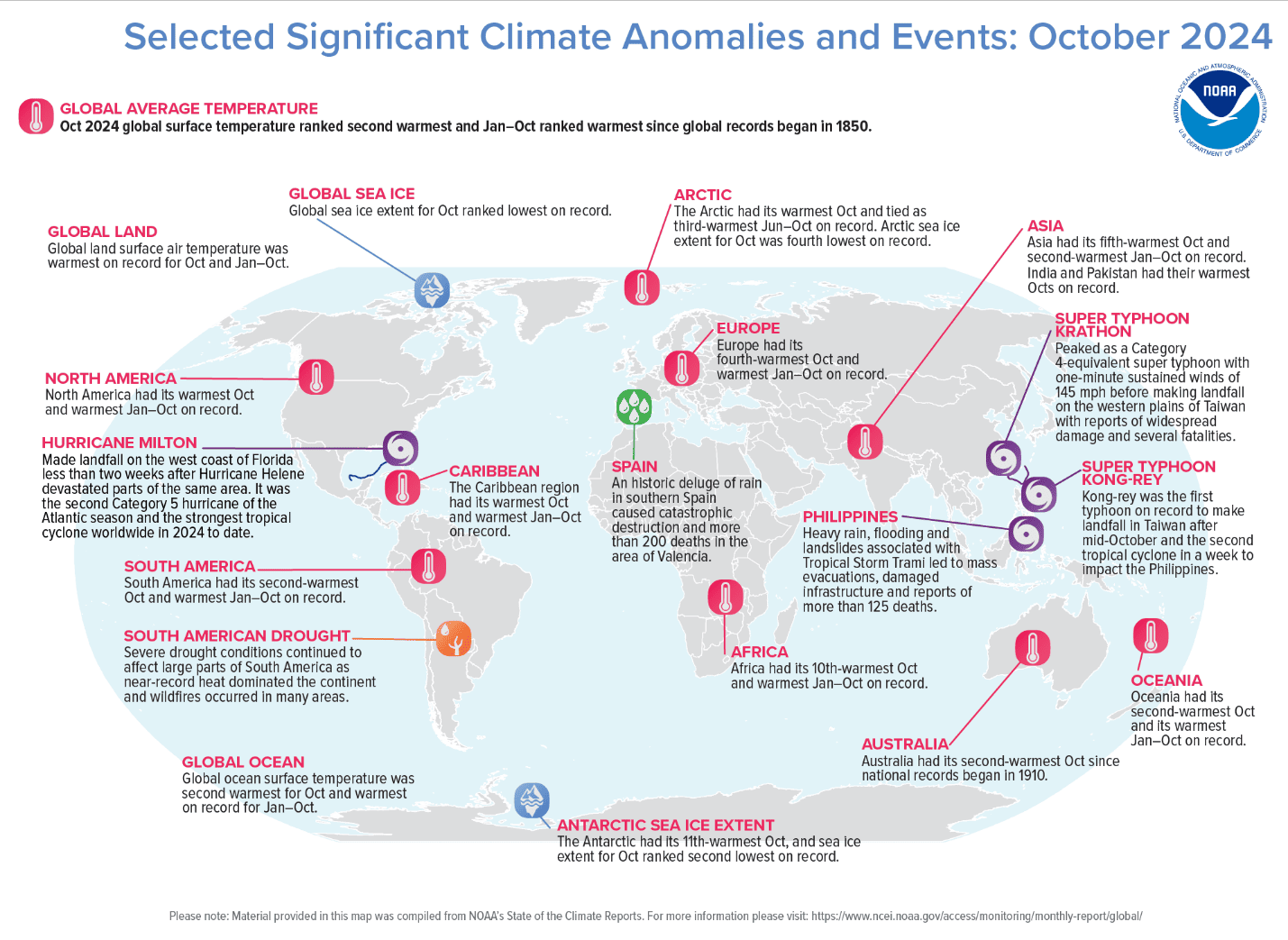
Fig 1 Selected Significant Climate anomalies, found at more details
And warning that the “Earth is becoming hotter and more dangerous for everyone, everywhere”.
Then in October the NOAA announced October 2024 was the second warmest October on record for the globe in NOAA's 175-year record and significant climate anomalies from around the world. (Fig 1)
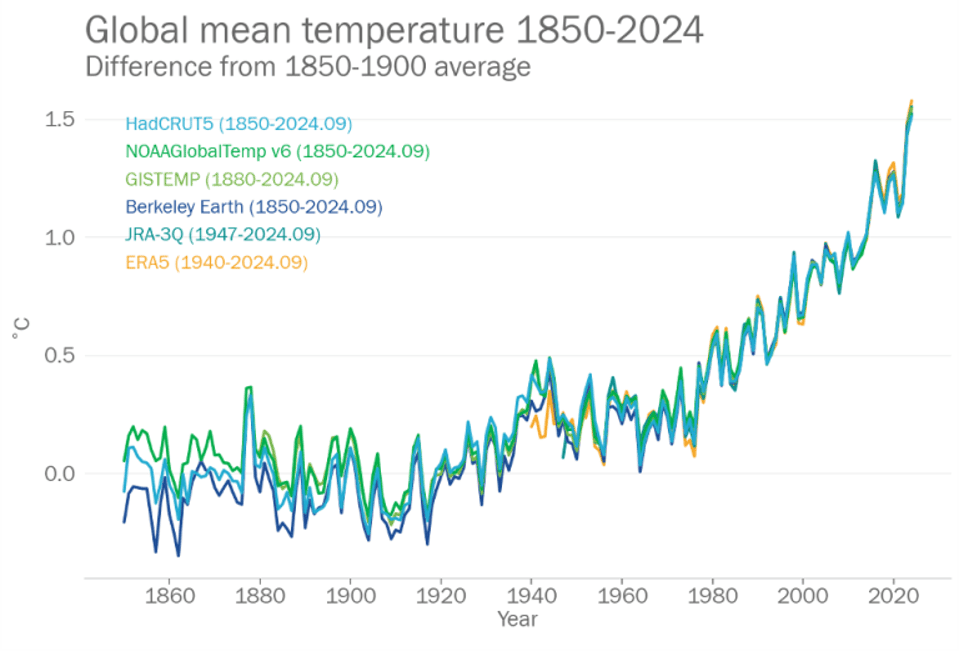
Fig 2 Global mean temperatures from 1850 to 2024 compiled by the WMO found at more details
At the time of writing, it seems that 2024 has been the warmest year on record and, even worse, possibly the first year to break the 1.5OC global warming target set by the International Community under the Paris Agreement. This unwelcome record was reported by the European Union's Copernicus Climate Change Service (C3S) just a week before COP29 (Conference of the Parties, 29) in November4 and about a week later, during the conference, in a press release by WMO5.
In December Marshall Shepard, writing for Forbes summarised all proceeding climate reports of the year with an article titled, “2024 Likely The Warmest Year On Record - Why It Matters To You”6 where the reporter sets out many of the negative aspects of this continuing warming, in summary he says “I could write an encyclopaedia of the ways climate warming is affecting our lives. And that is concerning.”
It is well documented that as the climate warms it will “… likely cause more intense rainfall and have an increased coastal flood risk due to higher storm surge caused by rising seas…, the global frequency of storms may decrease or remain unchanged, but hurricanes that form are more likely to become intense.” (Colbert, A. 2022)7.
So, it should come as no surprise that there has been an increase in major storms (called, Hurricanes in the West and Typhoons and Cyclones in the East) developing in the oceans of the world. Many countries have documented significant damage from these storms this year, including both the East and West coast of the USA and, in the east Pacific; China, Japan, Korea and the Philippines (see fig 3) where at one point in November, 4 major storms could be seen from space heading westward towards Philippines.
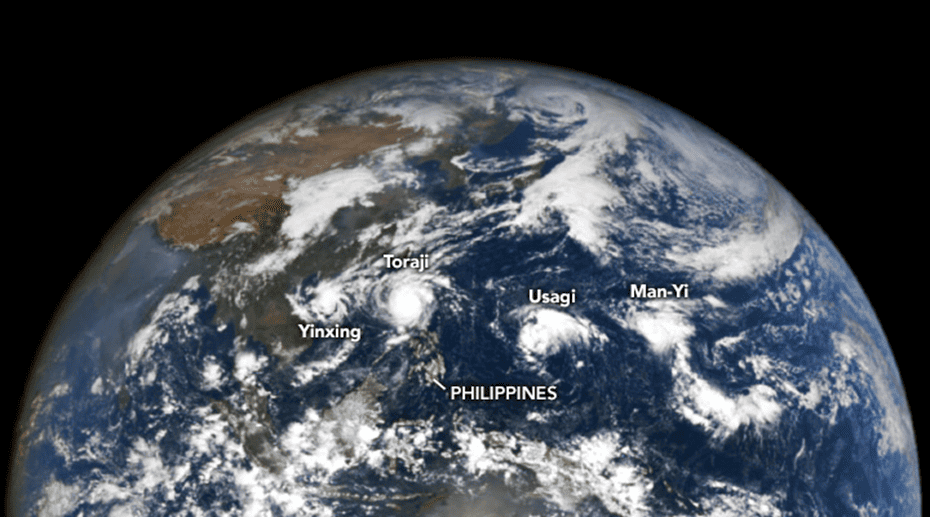
Fig 3 Nov 11 2024 Four named storms visible at the same time moving towards Philippines. Found at Https://eoimages.gsfc.nasa.gov/images/imagerecords/153000/153575/fourstorms_epc_20241111_lrg.jpg
Africa too has suffered, with in December, a cyclone that wreaked havoc in the French Indian Ocean territory of Mayotte,8 then moved on to Mozambique where the BBC reported “Cyclone Chido kills 94 people in Mozambique”9 exactly the scenario scientists have warned about, where storms become stronger and more deadly, as global temperature rises and ocean storms become stronger and stronger.
It is not only coastal areas at risk as we have seen during this year with floods and fires throughout Europe, USA, China, Bangladesh and other parts of the world during the year, the climate is beginning to affect the weather for more and more people.10
In conclusion I will quote Esme Stallard, writing for the BBC11 “This was a year of heat - temperature records were broken on land and in the sea multiple times.” With, she warns; “Researchers from the World Weather Attribution (WWA) group at Imperial College [London] and Climate Central [more details] said the study shows "we are living in a dangerous new era".”
2. Kazakhstan/CIS Climate Change
In our Q2 newsletter we discussed the April floods in Kazakhstan and that by April 17th, Reuters were reporting; “Almost 117,000 people have been evacuated due to floods in Kazakhstan…”12 These were the worst floods in 80 years and by June had already cost the country some US$127 million and were expected to costs some US$700 in total,31 or about 5 times the country’s renewable budget for 2024!13
During the COP29 gathering in Baku (Azerbaijan) on the coast of the Caspian the shrinking of the Caspian Sea became a focus of interest, some blamed oil exploration, seismic activity, damns on the rivers Volga and Ural, the Azeri representatives suggested it was just natural variation, with that the Caspian Sea's fluctuations are natural cycles; whatever the reason, the drop in water level is now beginning to affect the local area. In May, 2024 the Voice of America (VoA) reported that; “Aqtau city officials declared a state of emergency over declining water levels in June 2023. The Kazakh Ministry of Environment said the situation was "critical.".” 14 Local water ways and ports are being negatively affected and even the operation of the Atyrau desalination plant (for drinking water) is threatened. Whatever the reason or reasons behind the drop a recent 2023 study15 suggests “anthropogenic influence, global warming through changes in precipitation, evaporation and wind regime will have significant impact on the Caspian Sea level” meaning climate change will add to any other reasons that may be causing the drop in sea level; and a lower sea level will have far reaching consequences for all the countries sharing the coastline.
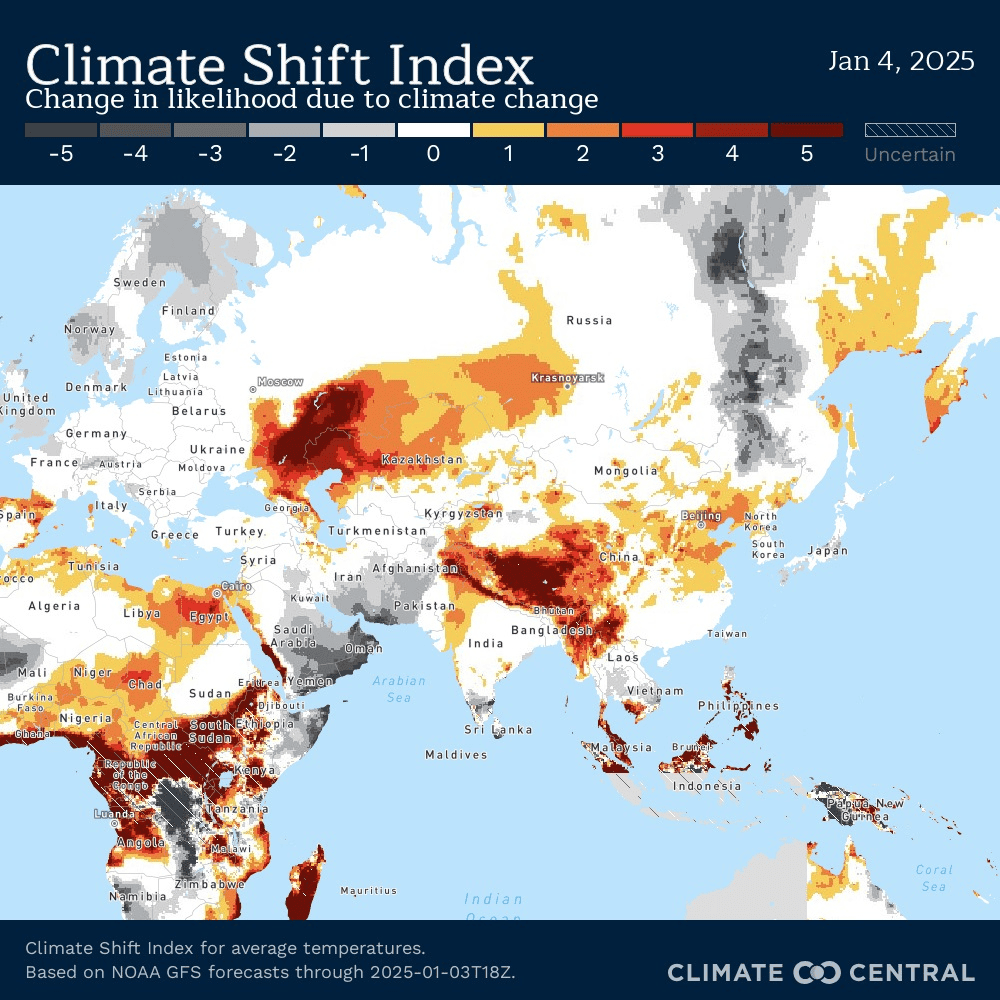
Fig 4 predicted change (shift) in regional temperatures
Found at more details
As reported in our Q3 newsletter the future climate of Kazakhstan will be different to that of today (see fig 4) and Kazakhstan is already changing its energy generation to greener alternatives and developing mitigation plans and strategies to manage the worst impacts of Climate-Change where possible.
At the end of October, 2024, the UNDP Resident Representative in Kazakhstan, Katarzyna Wawiernia, titled her official blog;
“Kazakhstan steps up to the plate on climate change – creating a road map for a more sustainable future”16 in which she highlights that “In recent years, Kazakhstan has faced numerous emergency situations directly linked to climate change.” and that they must develop plans and strategies “that reflects Kazakhstan’s unique vulnerabilities and priorities.”
The blog can be found here UNDP however the main subject of interest in this newsletter is energy generation and progress reducing GHG emissions.
3. Renewable Energy Sources in Kazakhstan
Kazakhstan has significant Renewable Energy potential as reported by the OSCE17 (fig 5)
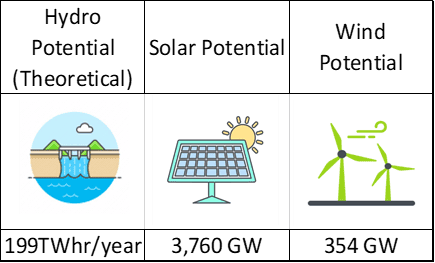
Fig 5 Potential energy from the main Renewable sources; extract from OECD, Advancing Energy Security in Central Asia, page 6
The 3 mainstream RES, namely Hydro, Solar and Wind are well represented, there is also potential for biomass in the agricultural north of the country and the possibility for nuclear power too especially as Kazakhstan has plentiful Uranium reserves.
In May 2023 the UNDP reported that as of 2021 Kazakhstan’s Renewable Energy production was as follows18:

- Bukhtarma Hydro Power Complex of Kazzinc LLP,
- AEС Ust-Kamenogorsk HPP LLP,
- AEС Shulbinsk HPP LLP.
producing well over 1GW of electricity power with, according to the ITA19 “15 large hydropower stations (>50 MW) with a total capacity of 2.25 GW account for up to 13 per cent of the country’s total generating capacity.” It appears that these historic Hydro assets are excluded from the country’s RES but that the “new” production of renewable energy is rising, to quote
Fig 6 Electricity generation by RES types in 2023. Found in “Analysis of the wholesale electricity and capacity market” page 16 (KEGOC 2023)
KEGOC20 “Electricity generation by renewable energy sources, … has an upward trend every year. [In] 2009 … the share of green power plants in total electricity generation was less than 1%, in 2023 this indicator has already reached 6%.” and breaks down as shown in fig 6.
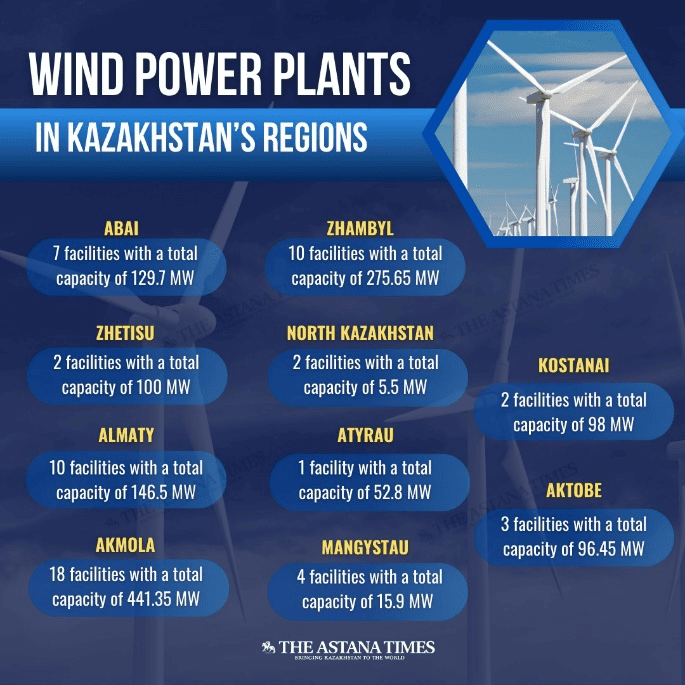
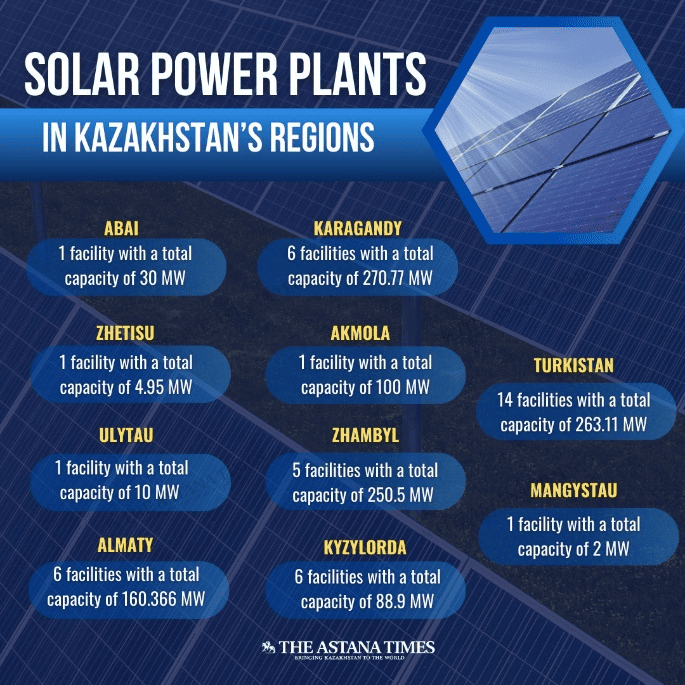
Fig 7 The RES (wind and solar) projects currently working in country
according to the above there are a total of 59 wind farms and 42 solar parks delivering 1,362MW and 1180MW respectively, a potential of more than 2GW of renewable energy.
Qazaq Green, a local green energy information poral22 reported in March “Kazakhstan's renewable energy generation reaches 5.92%” referring to:
· 59 wind power plants with a capacity of 1,409.55 MW;
· 46 solar power plants with a capacity of 1,222.61 MW;
· 39 hydroelectric power plants with a capacity of 269.605 MW;
· 3 biogas power plants with a capacity of 1.77 MW.
These figures are broadly in line with the KEGOC findings. Kazakh Green goes on to report that by 2027, the country plans to commission 25 RES projects with a potential capacity of a further 599.85 MW.
4. Large Projects
We reported in Q3 that “The commissioning of five large renewable energy projects with a total capacity of 5 GW is planned for 2029-2030,”23 and that 3 were moving forward.
The first was announced in June of 2023 by TOTAL Energies; “a 25-year PPA for a 1 GW (1,000MW) Wind Project”24 and we (3E) can confirm the project has commenced as we have been engaged as a subcontractor during the initial survey and planning of the site and that engineering design, that includes energy storage (ESS), has now commenced. Importantly these large projects are planned to include ESS something that is required more urgently as RES capacity increases and the problems with curtailment* increases.25
We understand from Kursiv Media that the second large project will be constructed by MASDAR (UAE), and that the details are being negotiated for the Jambul region of Kazakhstan.26
* Curtailment occurs when the grid is unable to accept all the renewable energy being produced and so production is “curtailed” and excess energy dumped, or production turned down because of lack of storage capacity.
Concerning the third, ACWA Power a leading Saudi developer, we have been unable to discover any further developments reported following the MoM signing in Astana in March 202427. As for the other two projects of the five we have seen no new news to date.
We look forward to further news and advances in 2025
References and Further reading
1 Younger, S. (2024) NASA Analysis Confirms a Year of Monthly Temperature Records. Retrieved from https://www.nasa.gov/earth/nasa-analysis-confirms-a-year-of-monthly-temperature-records/
2 Dickie, G. (2024). World recorded hottest day on July 21, monitor says. Retrieved from https://www.reuters.com/world/world-registers-hottest-day-ever-recorded-july-21-monitor-says-2024-07-23/
3 UN. (2024). UN Secretary-General issues call to action on extreme heat. Retrieved from https://wmo.int/news/media-centre/un-secretary-general-issues-call-action-extreme-heat-0
4 Copernicus: 2024 virtually certain to be the warmest year and first year above 1.5°C. Retrieved from https://climate.copernicus.eu/copernicus-2024-virtually-certain-be-warmest-year-and-first-year-above-15degc
5 WMO. (2024). 2024 is on track to be hottest year on record as warming temporarily hits 1.5°C retrieved from https://wmo.int/news/media-centre/2024-track-be-hottest-year-record-warming-temporarily-hits-15degc
6 Forbes. (2024). 2024 Likely The Warmest Year On Record - Why It Matters To You. Retrieved from https://www.forbes.com/sites/marshallshepherd/2024/12/07/2024-likely-the-warmest-year-on-recordwhy-it-matters-to-you/
7 NASA (2022). A Force of Nature: Hurricanes in a Changing Climate. Found at https://science.nasa.gov/earth/climate-change/a-force-of-nature-hurricanes-in-a-changing-climate/
8 Newsweek (2024) Maps Show How Cyclone Chido Has Devastated French Island Mayotte. Retrieved from https://www.newsweek.com/mayotte-cyclone-chido-france-help-2001241
9 BBC (2024). Cyclone Chido kills 94 people in Mozambique. Retrieved from https://www.bbc.com/news/articles/c938wn7k2v3o
10 Worldweatheronline (2024).2024: A Year in Review – Global Weather Extremes Retrieved from https://blog.worldweatheronline.com/weather/2024-a-year-in-review-global-weather-extremes/
11 BBC (2024). A year of extreme weather that challenged billions. Retrieved from https://www.bbc.com/news/articles/ckg8dg3ke40o
12 Reuters (2024) Retrieved from https://www.reuters.com/world/asia-pacific/almost-117000-people-evacuated-due-floods-kazakhstan-2024-04-17/
13 Astana Times (2024). Kazakhstan Flood Recovery: Thousands Compensated, Tokayev Urges Swift Action. Retrieved from https://astanatimes.com/2024/06/kazakhstan-flood-recovery-thousands-compensated-tokayev-urges-swift-action/
14 VOA (2024). Shrinking Caspian Sea worries environmental activists. Retrieved from https://www.voanews.com/a/shrinking-caspian-sea-worries-environmental-activists/7613064.html
15 H. Lahijani, S.A.G. Leroy, K. Arpe, J.-F. Crétaux. (2023). Caspian Sea level changes during instrumental period, its impact and forecast: A review. Found at https://doi.org/10.1016/j.earscirev.2023.104428
16 Wawiernia K. (2024). Kazakhstan steps up to the plate on climate change – creating a road map for a more sustainable future. Retrieved from https://www.undp.org/kazakhstan/blog/kazakhstan-steps-plate-climate-change-creating-road-map-more-sustainable-future
17 OSCE. (2022). Advancing Energy Security in Central Asia. Found at https://www.osce.org/oceea/513787
18 UNDP (2023) Reducing temperatures: Kazakhstan takes action against climate change. Found at https://www.undp.org/kazakhstan/news/reducing-temperatures-kazakhstan-takes-action-against-climate-change
19 International Trade Administration (2022). Kazakhstan - Country Commercial Guide. Found at https://www.trade.gov/country-commercial-guides/kazakhstan-power-generation
20 KEOGOC (2023) analysis of the wholesale electricity and capacity market found at https://www.kegoc.kz/en/electric-power/elektroenergetika-kazakhstana/


